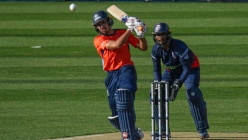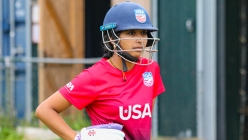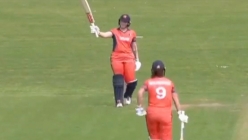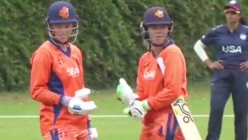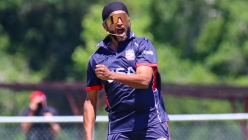USA Cricket News
USA Cricket: 2023 ICC Women’s U19 T20 World Cup Tour Review Part 3 - Outlook for the Future
2023 Feb 02 by DreamCricket USA
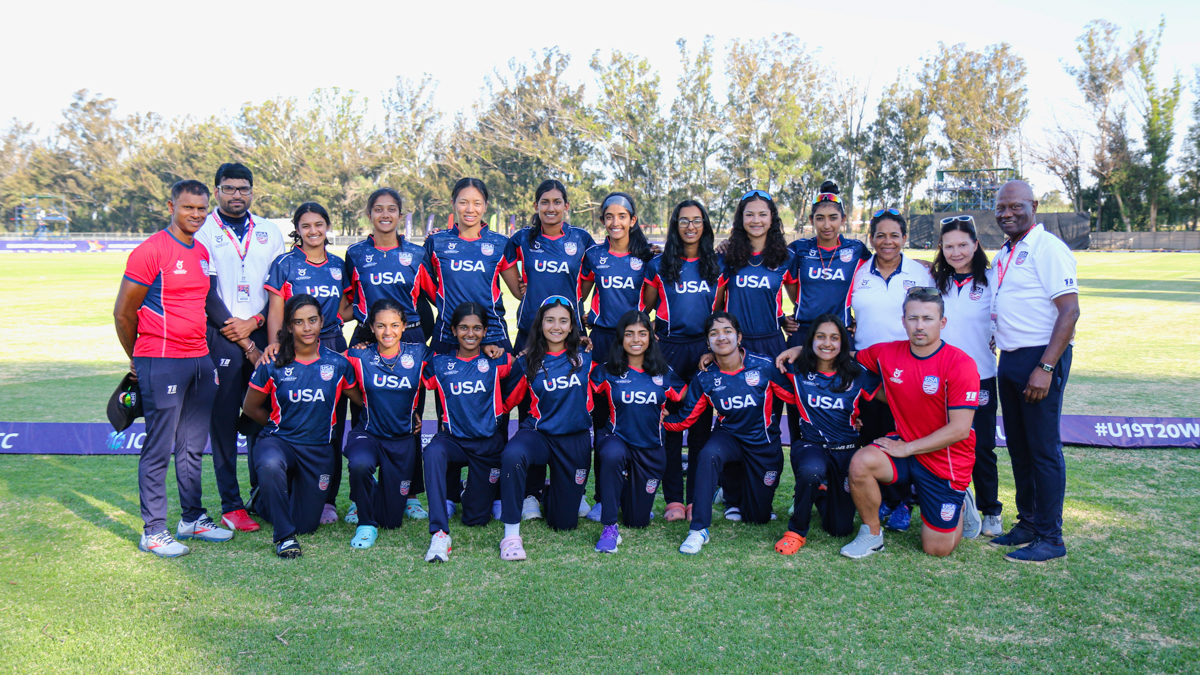
By Peter Della Penna (Twitter @PeterDellaPenna)The final part of the tour review for the USA Women's U19 squad's tour of South Africa for the 2023 ICC Women's U19 T20 World Cup focuses on the infrastructure and player development issues that need to be cured for USA's player development to be improved individually and collectively to close the gap with other countries.
Photo credit: Peter Della Penna
To start, it’s worth looking at some of the issues that were highlighted as systemic problems in the post-tour review of the 2019 ICC Women’s T20 World Cup Qualifier in Scotland to see how much has changed (or not changed) in the three and a half years since that tournament in terms of the broad picture of women’s cricket in America. Looking at the core issues, there has been negligible progress in a number of areas: game-awareness, skills development, overall athleticism, overall talent, talent recruitment.
Much of what was written then could be copy and pasted again in 2023 to summarize where USA stands and much of it can be drawn from how the team presents itself in the field. Compared to their age group peers, the overwhelming majority of USA’s players are:
- Too slow reacting to the ball off the bat
- Take poor angles/routes to the ball
- Poor catching techniques
- Routine misjudgments of chances in the air resulting in not getting a hand to the ball
- Poor footspeed to the ball along the ground and in the air
- Weak throwing arms, both in the ring and from the boundary
- Inaccurate throwing arms, both in the ring and from the boundary
- Poor awareness regarding backup and/or relay rotational positioning
These are all skills that should be developed from a young age through other sports and translated into cricket. They are not things that a cricketer starts to learn from scratch the first time they come to pick up a bat and ball. But the evidence on show indicates that a good portion of players are specializing too early into cricket and not developing core athletic skills from other sports.
Conceptualizing it a different way, many of these traits manifest themselves in a gym class game of dodgeball: footspeed to sprint to center court and pick up the dodgeball when the whistle is blown to begin a new game, arm strength and accuracy to hit a stationary or moving target, agility to catch a dodgeball as well as agility to avoid being hit by one, awareness of where the other dodgeballs are that are in play and the distance from any person who might be throwing. Let’s say that instead of playing a game of cricket against Bangladesh, Australia, Sri Lanka and Scotland, World Cup organizers decided to play a game of dodgeball instead. They then announce that the 30 squad members between USA and their opponent on that given day will be mixed into an open pool to choose from and each captain will get to draft a 15-player dodgeball squad using alternating draft picks. In this scenario, would a USA player ever be the first player chosen? Would a USA player even be one of the first five players chosen? Or even one of the first 10 players chosen?
In September 2019, the tour review included a section in reference to the wisdom of paying significant money for the services of then USA Women’s head coach Julia Price which stated, “Gary Kirsten, John Buchanan, Bill Belichick, Vince Lombardi, Phil Jackson, Gregg Popovich, Pat Summitt, Geno Auriemma, Mike Krzyzewski, Scotty Bowman, Joe Torre, Alex Ferguson. Take your pick, cricket or non-cricket, of the greatest coaching minds in men’s or women’s sports that the world has ever seen. If you put them in charge of coaching this USA Women’s team, the results would not change.”
There is little evidence to demonstrate that this would be any different in 2023, whether the coach is Shiv Chanderpaul or anyone else. USA simply does not have adequate talent to justify spending money on a high-profile coach with the idea that it will make a difference on high performance results.
Back in 2019, USA’s female player pool was hovering around 100. According to the most recent USA Cricket AGM in 2022, the number had grown to 283. While that number is encouraging, showing that the pool to draw from has nearly tripled in three years, it is still a drop in the ocean and shows how weak USA’s foundational position was in 2019.
USA effectively has two tiers of players at the moment. Those in the national squad are a product of intense private academy coaching and show what pouring lots of money in a concentrated area can result in. However, there is a massive gulf between those players and everyone else. There is hardly any middle tier of players. It's either elite, or beginner. One thing it means from a national team point of view is that players who make the national team often rise to the top without much internal competition and accumulate impressive looking stats by bullying inferior batting and bowling which currently makes up the overwhelming majority of the domestic playing base. What is the value of a half-century or century scored against a team who might only have three or four players in their starting XI who are legitimately competitive beyond a beginner stage playing level? And what does it say when none of USA's players are capable of scoring even a half-century when pitted against players at a national level who are all within their category? How good is a multiple-wicket haul if it comes against a player batting at No. 4 or 5 who can't keep out a straight ball?
What it also means is that USA is having to spend incredible amounts per player to achieve progress, whereas mass market participation would naturally produce better players with a lower per player cost investment because better athletes would naturally funnel their way towards the top of the pyramid through the sheer volume of people playing and the law of statistical probabilities.
To put it a different way, if the USA Senior national team at Women’s or U19 level is going to become competitive with other countries based on crude mathematical probability, USA’s national team players need to be inside of the top 1% of cricketers in the overall player pool. Simple math dictates that if you want players to represent the top 1% of your national team player pool, then there needs to be at least 1,500 registered players nationwide to get the top 1% to comprise a 15-player squad. If USA is currently drawing from 283 players, it means they are drawing from the top 5.3% of players. So even at the elite level, there is an extreme amount of homogeneity in statistical performance because the players who rise to the ostensibly elite level are in fact players who are in the top 5% rather than the top 1%. In most national team setups with a robust playing base, players between the top 5% and top 1% tend to produce mediocre to above average performances at their peak level of production. USA's top players have a false projection of their actual value because in most other setups, they would be nowhere near the national team but are benefitting from opportunities that exist principally because of USA's shallow player pool, and not through exceptional performance typically generated by someone in the top 1% of their field.
Translated a different way, just by raw math, it means that 12 or 13 out of USA’s 15 squad members are outside of the top 1% of players in the country. If they were to compete in a more robust national team setup in another national team setup, it means that at best only 3 out of USA’s 15 squad members in South Africa would be reasonably expected to compete and replace a player in another national team squad. That math comes out looking pretty accurate if one were to do a head-to-head matchup of USA’s players compared to other squads throughout the World Cup. Scotland is a prime example. Looking through a clear-eyed lens, it’s hard to objectively see more than three of USA’s players breaking into the Scotland XI.
Rather than spending money on a high-priced coach, USA administrators should be dedicating more financial resources to growing the women’s playing pool. It needs to grow to six times its current size before USA can realistically be picking the top 1% of players in the country at Women’s Senior or U19 level. Doing so will naturally result in better all-round athletes entering the player pool, which will have a trickle-down effect on core elements of fielding and running between the wickets, as well as power-hitting and boundary striking, and unearthing pace bowlers who can bowl at far quicker pace.
The results of the team also raise questions with regards to the effectiveness of high-priced academy coaching in their local regions. Specifically, what is actually being taught at these academies? Not only are USA’s players deficient when it comes to fielding (which makes it abundantly obvious that local coaches are spending little to no time on fielding principles and fundamentals), but the overwhelming majority of players do not demonstrate any footwork whatsoever, whether against pace or spin. They do not use the depth of the crease to go forward, backward, move across their stumps, back away from leg stump, anything to create different scoring angles or disrupt the bowler from their rhythm. They do not sweep, nor do they use their feet to come down the pitch.
The best way to describe the majority of USA’s batting approach is “static”. Players rely heavily on scoring option A, which is generally a half-volley outside off stump. When scoring option A dries up, there is scant evidence that players have a scoring option B to access. Are the players actually being challenged by their local coaches to find and develop different ways to score, particularly against good bowling? Or is coaching confined to hours on end setting up a bowling machine so a player can perfect their shots to bad ball bowling (set the bowling machine to half-volleys on fifth stump, half-trackers on seventh stump), rather than forcing them to navigate options against what will be a more realistic simulation of an in-match challenge? If these things are being practiced during indoor sessions, they are not being converted with confidence into live-match scenarios.
This segues into another significant issue on the coaching front. Anecdotal evidence indicates that players are spending a severely unbalanced amount of time in practice compared to matches. It results in game-awareness lagging severely behind the technical skills development. So even if different layers of more advanced batting and bowling approaches are being introduced and encouraged during indoor training sessions, the players wind up looking like they’re going through a baptism by fire when they walk into a field with nine fielders plugging gaps that were vacant on an indoor bowling machine.
The majority of these things can arguably be self-correcting when the player pool grows. Higher volumes of player participation will lead to better players rising to the top. More players participating will also incentivize more and better facilities to be built by local municipalities rather than relying on private investment for these facilities to be built. It also raises the probability of the facilities that are being built new to be built to a higher daily maintenance standard so that bad fielding habits developed on poorly maintained outfields will be reduced, and bad batting habits developed on similarly poor outfields will also be reduced.
One domino leads to the next one falling. More dominos need to fall though in order for USA’s results to consistently improve on field against a similar or elevated standard of competition. Otherwise, the rare victories that do come will be happy accidents that continue to mask longstanding structural issues that need to be corrected for long-term sustainable success to be achieved.
[Views expressed in this article are those of the author, who was present in South Africa for all of the USA Women’s U19 team’s matches on tour, and do not necessarily represent the views of DreamCricket management. If you have different views or opinions, we respect those views and urge you to provide your feedback, both positive and negative. Feel free to respond to the author via Twitter @PeterDellaPenna.]
